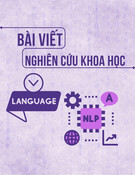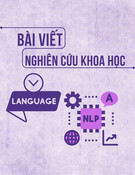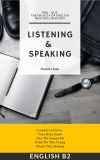
103
HNUE JOURNAL OF SCIENCE
Social Sciences 2024, Volume 69, Issue 4, pp. 103-111
This paper is available online at https://hnuejs.edu.vn/
DOI: 10.18173/2354-1067.2024-0072
PUBLIC SPEAKING ANXIETY AND STRATEGIES TO OVERCOME
THROUGH PUBLIC SPEAKING SKILL TRAINING
Nguyen Thi Thuy Linh*1, Thai Phan Bao Han2, Tieu Minh Son3 and Pham Thi Huyen4
1School of Foreign Languages, Can Tho University, Can Tho City, Vietnam
2Faculty of Social Sciences, Can Tho University of Technology, Can Tho City, Vietnam
3Student Success Center, Van Lang University, Ho Chi Minh City, Vietnam
4Faculty of Education, University of Social Sciences and Humanities, Vietnam National
University, Ho Chi Minh City, Vietnam
*Corresponding author: Nguyen Thi Thuy Linh, e-mail: thuylinh@ctu.edu.vn
Received October 29, 2024. Revised November 26, 2024. Accepted November 30, 2024.
Abstract. Public speaking is recognized as one of the most essential skills in the 21st century,
playing a crucial role in assessing students’ speaking abilities and overall communication
competence. This is especially important for EFL university students, who face significant
challenges in mastering public speaking. This study aims to investigate the causes of public
speaking anxiety and examine the effects of workshops on improving students' public
speaking skills. Data were collected through questionnaires with 135 university students in
Can Tho city. The findings indicate that the strategies introduced in workshops have a
positive impact on students’ public speaking abilities, with fear of negative evaluation
identified as the primary source of anxiety. The study also provides pedagogical implications
for lecturers and school administrators.
Keywords: public speaking, soft-skill workshops, university students, anxiety.
1. Introduction
Public speaking is an action in which the speaker has the goal of conveying a message orally
to the audience [1]-[3] Public speaking anxiety, a fear of speaking in front of an audience, is a
common phenomenon that afflicts people of all ages and backgrounds [4]. From students
delivering presentations in classrooms to professionals giving business pitches, this fear can
significantly impact one's confidence, career prospects, and overall quality of life [3], [5].
According to Horwitz, Horwitz, and Cope (1986), being fearful of negative evaluation is one of
the elements of foreign language anxiety [6]. While the fear of public speaking has been well-
documented, there remains a need for a deeper understanding of the underlying causes and effective
strategies to address this issue, particularly among students since with appropriate strategies,
presenters can overcome the fear and perform more successfully [3], [4], [6]. While numerous
studies have explored public speaking anxiety, there are still gaps in the literature. For example,
while we know that factors such as fear of negative evaluation and lack of preparation can contribute
to anxiety, little is known about the specific cognitive processes involved [7]. Additionally, while
there is evidence that training programs can effectively reduce anxiety, there is a need for more
research on the long-term effects of these programs and the optimal components of such training.

Nguyen TTL*, Thai PBH, Tieu MS & Pham TH
104
The current study aims to address these gaps by exploring the primary causes of public
speaking anxiety among students. It examines the impact of factors such as anxiety, fear of
judgment, and low self-esteem on public speaking ability. Furthermore, the study will analyze the
effectiveness of a series of soft skills workshops in reducing public speaking anxiety through skill
training. Finally, the research will propose practical strategies to help students overcome their fear
and develop confident public speaking skills. By conducting this research, we hope to contribute
to the existing body of knowledge on public speaking anxiety and provide valuable insights for
educators, trainers, and students alike.
This study seeks answers to the following three research questions:
1. What is the level of public speaking anxiety among students participating in the
workshops?
2. What factors contribute to public speaking anxiety among students participating in
workshops?
3. To what extent do students' public speaking skills improve after participating in a series
of workshops?
2. Content
2.1. Theoretical Frameworks
The theoretical frameworks used in this study provide important insights into the
psychological and behavioral elements of anxiety regarding public speaking and performance,
including (1) Social Anxiety Theory, (2) Self-efficacy Theory, and (3) Stress Inoculation Theory.
2.1.1. Social Anxiety Theory (SAT)
Social Anxiety Theory (SAT) [8]-[12] informed the assessment of participants' anxiety,
highlighting concerns about being judged by others during public speaking. In the context of
public speaking, this theory helps to understand why some individuals feel heightened levels of
anxiety when they are required to speak in front of an audience.
2.1.2. Self-efficacy theory
Self-efficacy theory [13]-[17] provided insight into participants' perceived capacity to
manage stress related to public speaking. According to this theory, participants with higher self-
efficacy are more likely to believe they can prepare effectively, manage their anxiety, and deliver
a competent presentation.
2.1.3. Stress Inoculation Theory
Stress Inoculation Theory (SIT) [17], [20] was applied to evaluate participants' beliefs in the
effectiveness of the strategies taught during the workshop. SIT is a cognitive-behavioral
framework that helps individuals build resilience to stress by teaching them how to anticipate,
manage, and cope with stressors. In the context of public speaking workshops in this study, SIT
is applied to evaluate how participants perceive the effectiveness of the strategies taught to
manage their anxiety and enhance performance.
2.2. Methodology
2.2.1. Participants
This study collected data from 135 students who enrolled at universities in the South of
Vietnam. All students participated in the series of workshops “Shine confidently on stage” and
agreed to complete a survey. In the context of the present university, workshops are held to equip
participants with the knowledge and skills necessary for public speaking during semesters.

Public speaking anxiety and strategies to overcome through public speaking skill training
105
Workshops allow participants to listen to shared experiences, practice, and learn from their
experiences. The following tables depict the characteristics of participants.
Table 1. The demographic of respondents
Profile
Categories
Frequency
Percentage (%)
Gender
Female
71
52,5
Male
64
57,5
Total
135
100
Year of Study
First-year
82
60.7
Second year
15
11.1
Third year
4
3.0
Final year
34
25.2
Total
135
100
Major
English Studies
44
32,6
English Teaching
Education
41
30,3
Law
15
11,1
International
Business
14
10,5
Tourism
Administrative
Management
10
7,4
Vietnamese Studies
5
3,7
Soil Management
3
2,2
French Studies
3
2,2
Total
135
100
2.2.2. Instruments
A quantitative questionnaire was designed and used to seek the answers to the three
questions. Edwards (1991) highlights that a questionnaire is beneficial as “respondents will have
time to ponder privately before they reply, especially if questionnaires can be taken away and
returned later” [ 21]. Furthermore, Dörnyei (2003) emphasizes that questionnaires are effective
tools for gathering an overall understanding of the characteristics of a large population sample
[22]. This study used a questionnaire survey with 12 five-point Likert scale items, ranging from
“1-Strongly Disagree” to “5- Strongly Agree”. The layout of the questionnaire is presented in
Table 2. The layout of the questionnaire
Cluster
Research Content
Items
Cluster 1
The level of public speaking anxiety among students
participating in the workshops
Items 1-2
Cluster 2
Factors contributing to public speaking anxiety among students
participating in workshops
Items 3-9
Cluster 3
Participants’ self-perceived effect of participating in the
workshop on their public speaking skills
Items 10-12

Nguyen TTL*, Thai PBH, Tieu MS & Pham TH
106
To ensure the reliability of the questionnaire, a multi-faceted approach was implemented
throughout its development and administration. Initially, a pilot test was conducted with a group
of 30 participants to identify any ambiguities or inconsistencies in the items, allowing for
necessary refinements. Internal consistency was assessed using Cronbach's alpha, which yielded
a value of 0.72, indicating acceptable reliability for the items within each cluster. Additionally,
clear instructions were provided to participants to minimize variability in responses due to
misunderstandings, further enhancing the overall reliability of the data collected.
Table 3. Reliability Statistics of the Questionnaire
Cronbach's Alpha
Cronbach's Alpha Based on Standardized Items
N of Items
.71
.802
12
Several strategies were employed throughout its development and evaluation to ensure the
validity of the questionnaire. Content validity was established by consulting experts in public
speaking and anxiety management, who reviewed the items to ensure they adequately captured
the constructs being measured. Additionally, the questionnaire was designed to align with
established theoretical frameworks, such as Social Anxiety Theory, Self-Efficacy Theory, and
Stress Inoculation Theory, which provided a strong foundation for the relevance of the items.
2.2.3. Data Collection Procedure
Data collection occurred after the workshop, where participants were informed about the
purpose of the study. Those who volunteered were invited to complete the questionnaire, allowing
them to share their experiences and insights related to public speaking anxiety and the
effectiveness of the workshop. This approach ensured that participants understood the study's
objectives and could contribute their feedback voluntarily, fostering a sense of engagement and
willingness to provide honest responses.
2.2.4. Data Analysis
Data analysis involved quantitative methods to understand participants' experiences
comprehensively. For the quantitative data analysis, SPSS (Statistical Package for Social
Sciences) version 20 for Windows was employed. Several descriptive statistics were calculated
to summarize the levels of public speaking anxiety and the perceived effectiveness of the
workshop. Internal consistency was assessed using Cronbach's alpha, which yielded a value of
0.72, indicating acceptable reliability. Additionally, exploratory factor analysis was performed to
confirm the structure of the questionnaire and validate the identified clusters.
2.3. Results and Discussions
2.3.1. The level of public speaking anxiety among students participating in the workshops
The data from the questionnaire indicates a significant level of anxiety among students
regarding public speaking, as reflected in the table below.
Table 4. The level of public speaking anxiety among students participating in the workshops
Mean
Min
Max
Std.
Deviation
V.I.
The extent of students' anxiety in public speaking
among students participating in workshops
3.61
1
5
.92
High
Statements
1. When it comes to speaking in
public, I am totally nervous.
3.79
1
5
.89
Agree
2. I usually avoid speaking in
public.
3.51
1
5
1.11
Agree

Public speaking anxiety and strategies to overcome through public speaking skill training
107
The data indicates a significant level of anxiety among students regarding public speaking,
as reflected in the overall mean score of 3.61, categorized as “high.” The specific statement
assessing nervousness in public speaking has a mean of 3.79, suggesting a strong agreement
among participants that they feel nervous in these situations. Additionally, the statement regarding
avoidance of public speaking, with a mean of 3.51, further supports the notion that students tend
to sidestep these opportunities. The relatively high standard deviations for both statements imply
a notable variation in individual experiences, highlighting that while many students struggle with
anxiety, there may also be those who feel more comfortable. Overall, the findings underscore a
prevalent anxiety about public speaking that could be addressed through targeted interventions in
workshops.
The overall mean score of 3.61, categorized as “high” anxiety, and the specific mean of 3.79
for nervousness strongly align with Social Anxiety Theory. It suggests that students are
experiencing substantial fear of negative evaluation, which is a core aspect of social anxiety. The
data also indicates a tendency to avoid public speaking (mean of 3.51), reinforcing the idea that
anxiety significantly impairs students' willingness to engage in speaking opportunities. This
highlights the need for workshops to directly address these fears and provide students with
strategies to cope with the anticipated judgment of others.
2.3.2. Factors contributing to public speaking anxiety among students participating in
workshops
The results from the questionnaire depict several factors contributing to public speaking
anxiety among students participating in workshops, as following table.
Table 5. Factors contributing to public speaking anxiety
among students participating in workshops
Factors
Mean
Min
Max
Std. Deviation
V.I.
1. Fear of Negative Evaluation
4.01
1
5
1.06
Agree
2. Overestimation of
Consequences
3.70
1
5
1.03
Agree
3. Self-Perception
3.72
1
5
1.00
Agree
4. Social Comparisons
3.65
1
5
.93
Agree
5. Lack of Experience
3.41
1
5
.92
Agree
6. Physiological Responses
3.66
1
5
.88
Agree
7. Cognitive Distortions
3.30
1
5
.86
Moderate Agree
The data reveals several key factors contributing to public speaking anxiety among students
participating in workshops, with the mean scores indicating varying levels of agreement. The
highest mean, 4.01, corresponds to “Fear of Negative Evaluation,” suggesting that students are
significantly worried about how others perceive them during public speaking. This is followed by
“Self-Perception” at 3.72 and “Social Comparisons” at 3.65, indicating that students’ own views
of themselves and their comparisons with peers also play a considerable role in their anxiety. The
factors “Overestimation of Consequences” and “Physiological Responses” both have means
around 3.66, highlighting that students may exaggerate the potential negative outcomes of their
performances and experience significant physical symptoms of anxiety. Conversely, “Lack of
Experience” (3.41) and “Cognitive Distortions” (3.30) are associated with lower levels of
agreement, suggesting these factors, while still relevant, may have a lesser impact on students'
anxiety. This suggests that focusing too heavily on these areas may not yield as significant results
in reducing anxiety levels. Overall, the findings suggest that addressing fears related to evaluation
and self-perception could be critical in reducing public speaking anxiety in students.













![Đề cương môn Tiếng Anh 1 [Chuẩn Nhất/Mới Nhất]](https://cdn.tailieu.vn/images/document/thumbnail/2025/20251130/cubabep141@gmail.com/135x160/51711764555685.jpg)










![Mẫu thư Tiếng Anh: Tài liệu [Mô tả chi tiết hơn về loại tài liệu hoặc mục đích sử dụng]](https://cdn.tailieu.vn/images/document/thumbnail/2025/20250814/vinhsannguyenphuc@gmail.com/135x160/71321755225259.jpg)

